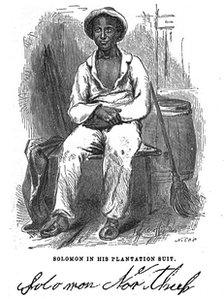12 Years a Slave: Who was Solomon Northup?
- Published

Solomon Northup as he appears in the original book and Chiwitel Ejiofor, who has been much-praised in the lead role of the film
With 10 Bafta and seven Golden Globe nominations, 12 Years a Slave looks set to triumph this awards season. The film is based on a 150-year-old account of how Solomon Northup, born a free man, was kidnapped into slavery. But who was Northup and why, until recently, was he virtually forgotten?
"I thought I knew a fair amount about American history," says John Ridley, "yet only a few years ago I hadn't even heard of Solomon Northup."
Ridley is a highly successful 48-year-old African-American writer, whose credits range from The Fresh Prince of Bel Air to the Iraq war satire Three Kings.
He's also the Bafta-nominated screenwriter of 12 Years a Slave.
"The fact that a well-educated guy like me didn't know Solomon's story says a lot about how ignorant America can be of parts of its past. I'm delighted to help return him to our nation's culture."
The book Twelve Years a Slave was published in 1853 by the American firm of Derby and Miller. It had been written very quickly, emerging only months after Solomon Northup escaped from a Louisiana plantation. Published in London at the same time, the book sold well at first - but by the end of the century was little read.
Ridley says the movie came about in part because he and director Steve McQueen share an agent.
"Steve and I sat down to talk one day and we quickly realised we were both keen to explore slavery as an idea. But it was Steve's wife Bianca (cultural critic Bianca Stigter) who gave him Solomon's book - otherwise I doubt we would have come across it.
"Steve loved the book and passed it to me. I thought it was a singular and evocative document. It's not long but I was overwhelmed by its scope and scale."

Ejiofor and Michael Fassbender have been nominated for Bafta and Golden Globe awards for their performances in the film
The narrative is straightforward: in 1841, Solomon Northup is living a settled and fairly prosperous life in Saratoga, near New York. He is a free man but is tricked into going to Washington DC, where he is drugged, kidnapped and sent south as a slave. Twelve years later, he gets word out to friends and is rescued.
Perhaps the real interest is the detail of slave life - both the harsh cruelty and the periods of domesticity. Relations with the owners who purchase Solomon along the way are crucial, especially with Edwin Epps (played in the film by Michael Fassbender).
The middle of the 19th Century saw the publication of many slave narratives in America, designed mainly to support the cause of abolition. The best-known (though much criticised since) was Uncle Tom's Cabin, which appeared in 1852.
That Twelve Years a Slave didn't slip into total obscurity was partly the work of Louisiana historian Sue Eakin. She died three years ago, aged 90, but her daughter Sara recalls years of helping with the research.
"When she was 11 or so, a neighbour gave Mom the book to read. She grew up near where Solomon had been a slave, so she was astonished and excited to find reference to plantations and even to families she knew well.
"Later, at college, Mom bought an old copy for 25 cents in Baton Rouge and the bookstore owner told her it was a worthless old potboiler and was probably all made up. That annoyed her so much she set out to discover more about Solomon and his life. I guess in those days no-one else was interested in him at all.
"Then, in 1968, she co-edited a new edition of the book. It was no bestseller but it was the beginning of it coming back into some sort of circulation. By then, it was more than a century old but Mom felt Solomon had written a fair account of how life in central Louisiana must have been. She felt it should be better known - though she'd be surprised to see that Solomon's suddenly world-famous."
There were always those who claimed Northup's tale was an exaggeration, or even a total fabrication written as anti-slavery propaganda. Sara is proud that her mother was one of the first to find detailed corroboration of his story.
"After he was freed, there is documentation of his attempt to secure legal redress against his kidnappers," she says. "It was a bitter experience for him because in the nation's capital, Washington DC, Solomon's colour meant he wasn't allowed to testify. So the court case got nowhere but the paperwork is now a big help to historians."
Professor Clifford Brown co-wrote a recent biography of Northup. He says that in the last 20 years, some of the detail of his life has become clearer.
"It's been a matter of looking carefully at census records and at maps of the time, or whatever. We have more detail now of how his father had been freed in 1798 and of the life Solomon and his wife Anne led in Saratoga before the kidnapping.
"The manifest of the ship which carried him to New Orleans exists in the US National Archives. That manifest contains names of people Solomon mentioned. There are also hospital records in New Orleans which feature his name.
"And, in January 1853, the New York Times had published a detailed account of Solomon's adventures which preceded the book and which tells the same basic story. So evidence of the book's accuracy is convincing."

The restored plantation home where Solomon Northup stayed while "owned" by Edwin Epps is now located on the Louisiana State University at Alexandria campus and open to the public.
A question long debated is the contribution of David Wilson, credited in 1853 as the book's editor. Some have claimed Wilson in effect wrote Twelve Years a Slave.
Professor Brown says it's clear the work was created by Solomon Northup relating his experiences to Wilson, who then knocked them into shape for publication.
"It's the equivalent today of a celebrity putting out a book 'as told to' a professional writer or journalist," he says. "Perhaps there are parts of the book where the tone is slightly more Wilson than Northup but that doesn't invalidate the tale he's telling."

Like Sue Eakin before him, Professor Brown has had to accept the fact that, a few years after his release in 1853, Solomon Northup simply disappears from the pages of history.
"It's a big frustration," he says. "We have no real idea where he spent his final years or what he was doing or where he died. Perhaps there's a gravestone somewhere with his name on it and we just haven't found it yet."
It has been suggested that after his escape from captivity, Solomon worked for the Underground Railroad which helped other slaves escape from the southern states, mainly to Canada, but as yet there is no conclusive evidence.
Professor Brown concedes that, even now, aspects of Solomon's life remain hard to pin down.
"For instance, the engraving of Solomon in the book's first edition I believe probably is a likeness of him, though no one can be sure. And it's even possible a photograph existed - photography was just starting in the 1850s. It's something we're actively trying to track down."
Perhaps if there were more visual evidence for Solomon's life, he wouldn't have disappeared into the shadows the way he did for most of the 20th Century.
Screenwriter John Ridley laments that currently we can't write the last act of Solomon Northup's extraordinary life-story. "He died invisibly and anonymously. That's kind of a sad irony: to disappear for 12 years, to be liberated and indeed become a bit of a celebrity… And then just vanish again.
"Hopefully with all the new interest in him, someone will be able to discover exactly what did happen to Solomon. That would be wonderful."
- Published8 January 2014
- Published7 January 2014
- Published18 October 2013
- Published3 January 2014